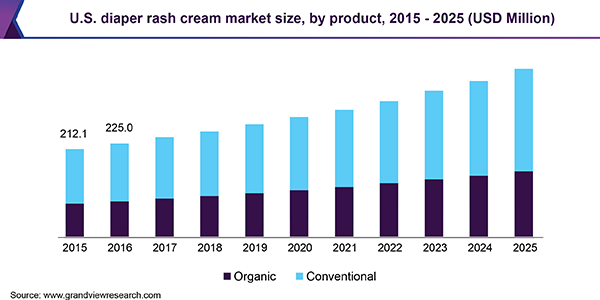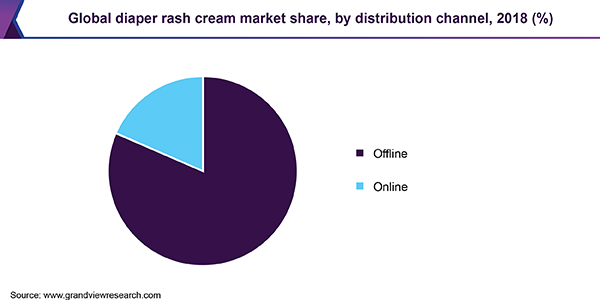- Home
- »
- Beauty & Personal Care
- »
-
Diaper Rash Cream Market Size, Industry Report, 2019-2025GVR Report cover
![Diaper Rash Cream Market Size, Share & Trends Report]()
Diaper Rash Cream Market Size, Share & Trends Analysis Report By Product (Organic, Conventional), By End User (Infant, Adult), By Distribution Channel (Offline, Online), And Segment Forecasts, 2019 - 2025
- Report ID: GVR-3-68038-331-7
- Number of Report Pages: 80
- Format: PDF, Horizon Databook
- Historical Range: 2015 - 2017
- Forecast Period: 2019 - 2025
- Industry: Consumer Goods
Report Overview
The global diaper rash cream market size was valued at USD 1.4 billion in 2018 and is expected to grow at a compound annual growth rate (CAGR) of 6.6% from 2019 to 2025. Rising awareness regarding infant health is a major factor driving the industry. Furthermore, increasing prevalence of chronic diseases and bedridden patients fuels the demand for rash cream and open new avenues for the market.

Over the past few years, millennial parents have become more conscious regarding the adverse effects associated with harmful chemical ingredients including phthalates and formaldehyde, which are used in the formulation of creams, shampoos, soaps, oils, and lotions used for baby care products. These factors have shifted consumer preference from chemical to natural and organic products.
In addition, the growing importance of health and hygiene, coupled with the benefits associated with the use of rash cream, is increasing the demand for rash cream during diaper use. An increase in literacy rate, rising number of working women, development of organic products, and aggressive marketing campaigns by manufacturers for child care have led to a shift in consumer behavior towards the use of rash cream with a diaper over traditional alternative products.
Diaper rash may lead to chronic diseases including Cellulitis, one of the serious bacterial infections found in the infants as well as in adults. According to a science journal published in August 2014, approximately 20% of the children or infants suffer from diaper dermatitis. These factors are expected to promote the product’s utility over the next few years.
Product Insights
Organic products are expected to expand at the fastest CAGR of 6.9% from 2019 to 2025 on account of increasing awareness regarding harmful chemicals and additives present in the conventional products available in the market. In addition, the segment is projected to witness growth in the coming years on account of its increasing popularity among health-conscious consumers. In order to cater to the increasing demand for rashes cream, manufacturers are focusing on new product development to increase customer penetration.
For instance, in October 2016, Hindustan Unilever entered in the baby care segment with a launch of a wide range of products including diaper rashes cream, lotion, shampoo, baby wipes, and soaps under the brand name ‘Dove’. The company is focusing on the development of products aimed at the emerging baby care segment over the forecast period.
End-User Insights
The infant segment is expected to register the fastest CAGR of 6.7% from 2019 to 2025 due to increasing awareness regarding the health and hygiene of babies. In addition, the segment is projected to witness growth on account of increasing government focus on baby hygiene products. Manufacturers are launching new products in line with the government policy guidelines.
For instance, in February 2019, Sebapharma GmbH & Co. KG launched pH 5.5 based baby care products including diaper rashes cream, which would be marketed by USV Pvt. Ltd. in India. According to the company, the product is 100% free from all harmful irritants and chemicals and is not being tested on animals.
Distribution Channel Insights
The offline segment was the largest distribution channel with a share of 83.6% in 2018. Major players including Walmart, Amazon, and 7-Eleven are significantly investing in developing countries such as India, Thailand, and Taiwan, in order to cater the increasing consumer demand in the region.

For instance, in March 2018, Apollo Pharmacy, a subsidiary of Apollo Hospitals Enterprise, integrated its 3000th unit in India. The company has planned to open more stores across the country owing to the rising demand for affordable drugs with round-the-clock services. In addition, 7-Eleven signed an agreement with Future Group to launch its first store in India, which is one of the fastest-growing retail markets. These initiatives are expected to help increase the product’s visibility over the forecast period.
The online distribution channel is expected to register the fastest CAGR of 7.6% from 2019 to 2025 owing to increasing internet penetration in various countries such as India and China. This, in turn, is likely to increase the growth opportunity for the diaper rash cream market over the forecast period. The online segment helps companies to reach a larger customer base. Moreover, the online platform provides product and price comparison, along with an easy return and timely delivery.
Regional Insights
Asia Pacific is expected to register the fastest CAGR of 7.1% from 2019 to 2025. New product launches in developing countries including India and Indonesia are expected to be prominent trends. For instance, in July 2017, Kino Corporation, a company pioneered in the manufacturing of skincare products in Indonesia, launched skin cream for infants, especially for the diaper rashes ‘Sleek Baby Diaper Cream’. The product consists of Olive leaf extract, which helps to protect from skin-irritating bacteria, and Chamomile and Sunflower extract, which acts as an anti-irritant to reduce redness.
North America is expected to exceed USD 495 million by 2025. Various stringent government policies and regulations on the infant or baby care products lead to strong innovation in terms of the development of new natural and organic products. According to the United States Consumer Product Safety Commission (CPSC), phthalate content is strictly prohibited in the baby care products across the country. These regulatory initiatives are expected to force the industry participants to develop organic diaper rash cream.
Key Companies & Market Share Insights
Moreover, key manufacturers are adopting market strategies including new product launch as per the guidelines provided by the government of respective countries, expansion of distribution channels, mergers, and acquisitions, in order to reach to a wider customer base as well as to cater to the increasing health-conscious customer base. For instance, in September 2015, Beiersdorf Inc. launched Baby Rash Cream under the brand name ‘Aquaphor’ in the U.S. The company launched this product to cater to the increasing demand for skincare products owing to rising prevalence of skin problems in infants and toddlers. These strategic moves are expected to increase the market share of the company in the near future.
Major players are increasing their product visibility geographically, especially in developed countries, in order to gain the maximum customer reach. Establishment of R&D centers for product innovation, coupled with strategic partnerships with investment companies in order to launch new innovative products as per the customer’s demand in the region, is expected to the reunion a critical success factor over the next few years. Taking into account all the above-mentioned factors, the producers are likely to focus on technology innovation catering to developing countries and untapped markets to gain maximum market share. Some of the prominent players in the diaper rash cream market include:
-
Bayer AG
-
Johnson & Johnson
-
Unilever
-
Beiersdorf Inc.
-
The Himalaya Drug Company
Diaper Rash Cream Market Report Scope
Report Attribute
Details
Market size value in 2020
USD 1.57 billion
Revenue forecast in 2025
USD 2.17 billion
Growth Rate
CAGR of 6.6% from 2019 to 2025
Base year for estimation
2018
Historical data
2015 - 2017
Forecast period
2019 - 2025
Quantitative units
Revenue in USD million and CAGR from 2019 to 2025
Report coverage
Revenue forecast, company ranking, competitive landscape, growth factors, and trends
Segments covered
Product, end user, distribution channel, region
Regional scope
North America; Europe; Asia Pacific; Central & South America; Middle East & Africa
Country scope
U.S.; U.K.; Germany; France; China; India; Brazil
Key companies profiled
Bayer AG; Johnson & Johnson; Unilever; Beiersdorf Inc.; The Himalaya Drug Company
Customization scope
Free report customization (equivalent up to 8 analysts working days) with purchase. Addition or alteration to country, regional & segment scope.
Pricing and purchase options
Avail customized purchase options to meet your exact research needs. Explore purchase options
Segments Covered in the ReportThis report forecasts revenue growth at the global, regional, and country levels and provides an analysis of the latest industry trends in each of the sub-segments from 2015 to 2025. For the purpose of this study, Grand View Research has segmented the global diaper rash cream market report on the basis of product, end-user, distribution channel, and region:
-
Product Outlook (Revenue, USD Million, 2015 - 2025)
-
Organic
-
Conventional
-
-
End-User Outlook (Revenue, USD Million, 2015 - 2025)
-
Infant
-
Adult
-
-
Distribution Channel Outlook (Revenue, USD Million, 2015 - 2025)
-
Offline
-
Online
-
-
Regional Outlook (Revenue, USD Million, 2015 - 2025)
-
North America
-
The U.S.
-
-
Europe
-
U.K.
-
Germany
-
France
-
-
Asia Pacific
-
China
-
India
-
-
Central & South America
-
Brazil
-
-
Middle East & Africa
-
Frequently Asked Questions About This Report
b. The global diaper rash cream market size was estimated at USD 1.48 billion in 2019 and is expected to reach USD 1.57 billion in 2020.
b. The global diaper rash cream market is expected to grow at a compound annual growth rate of 6.6% from 2019 to 2025 to reach USD 2.17 billion by 2025.
b. Europe dominated the diaper rash cream market with a share of 31.5% in 2019. This is attributable to stringent government policies and regulations on infant or baby care products that lead to strong innovation in terms of the development of new natural and organic products.
b. Some key players operating in the diaper rash cream market include Bayer AG; Johnson & Johnson; Unilever; Beiersdorf Inc.; and The Himalaya Drug Company.
b. Key factors that are driving the market growth include rising awareness regarding infant health coupled with increasing disposable income among working couples leading to higher consumption of the product.
Share this report with your colleague or friend.
![gvr icn]()
NEED A CUSTOM REPORT?
We can customize every report - free of charge - including purchasing stand-alone sections or country-level reports, as well as offer affordable discounts for start-ups & universities. Contact us now
![Certified Icon]()
We are GDPR and CCPA compliant! Your transaction & personal information is safe and secure. For more details, please read our privacy policy.
We are committed towards customer satisfaction, and quality service.
"The quality of research they have done for us has been excellent."





